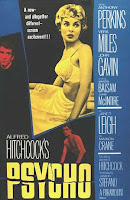Hey there!
I thought that I should just start off by saying welcome to my new blog! As stated on my actual page this blog will show all the evidence of my projects which consist of making a horror trailer, magazine and a film poster. Furthermore, I thought I should also state what I have been up to recently within my media classes. We've been focusing on the conventions within horror films and how we can intertwine these ideas into our horror film trailers. So far we've watched five films (not fully) to look at what are the typical conventions that most pre-modern fillms conist of, so here we go.
Nosferatu (1922)
Here is the opening scene that we studied:
Here is a link if you would like to watch the full movie of Nosferatu (1992):
Dracula (1992)
The next film we studied was Dracula which was an authorised adaptation of Bram Stoker's 'Dracula' directed by Francis Ford Coppola. Coppola thought it was absolutely crucial that the film stayed true to the narrative within 'Dracula' and so every scene has been articulated greatly so that the audience can relate what is happening within the scene with the novel. Additionally we studied the opening scene of the film and made close analysis on the conventions portrayed and the symbolism shown. A major theme shown within the opening scene is religion; religion is the reason why Dracula's wife to be died and religion (mainly concentrating on the people of the church) and the fact that his wife died is the reason why he had turned into the vampire as he drank the forbidden blood. The love between Dracula and his wife to be is conveyed as a transcendental love as there love will carry on even after they have died.
Psycho (1960)
This was the only film we watched full as a class and it was great that we did as this film is inspiring and memorable. Psycho was created and directed by Alfred Hitchcock, it caused controversy amongst the viewers and for the people within the film industry as it was different to any film before it. The actual film created the 'slasher' genre because of the graphic imagery, the techniques that were pursued for example within the shower scene and because a knife as a weapon had not been used in horror. *SPOILER ALERT* Additionally it was a unique narrative as the protagonist, a women called Marion Crane is killed within the first-forty five minutes. The antagonist which is actually Norman Bates dressed as his mother is intriguing as the character was inpsired by a man called Ed Gein. Ed Gein caused an uproar within America for his cruel acts which included, killing women, wearing their skins and additionally, he lived in isolation. We managed to study the whole of the film in which the main themes within it are betrayal, love and corruption.
Here is the most memorable and controversial scene with Psycho which is the shower scene:
Case 39 (2009)
We didn't spend a lot of time analysing case 39 however as a class we did get the idea of what was going to happen further on within the film. Case 39, directed by Christian Alvart is about a social worker who tries to help a girl called Lililth (nicknamed Lili) who appears to be having trouble at home with her parents. The social worked immediately assumes that the parents are controlling and abusing the child however she then later discovers from Lili that the parents want Lili dead. Lili and another worked called Wayne swoop into the rescue however, there is more to Lili then what meets the eye. I believe what I say from the film followed the conventions of horror as it includes a protagonist and an antagonist whilst having dark, mysterious events. Iconography is also within the film as there is blood which is a main convention within horror films, conveying death or pain.
Let The Right One In (2008)
Again, we did not study this film in detail but we studied the memorable moments from it for example the swimming pool scene. This Swedish film was directed by Tomas Alfredson and is about a little boy called Oscar who is bullied at school and consequently, does not have any friends. He meets a girl called Eli, who moves into the estate block that he is; Eli seems a shy girl and the two then become friends in which Oscar then finds out that Eli is a vampire. The narrative takes an interesting turn and the bond between the two friends strengthen as the narrative continues. I believe this film also follows the conventions of horror films as it includes scary moments that make the audience jump and nervous whilst having horrific events.
The Texas Chainsaw Massacre (1974)
 The Texas Chainsaw Massacre is directed by Tobe Hooper and it is in the genre of a cult horror film (slashser). Since it was run on a low budget the cast was made up of non-professional actors. Funnily enough, Hooper was hoping for a PG rating so this is why the gore is kept to a minimum however he failed as he got an 'R; rating due to the content and the narrative. Leatherface was inspired by Ed Gein so is similar Psycho as Norman Bates was inspired by Ed Gein also. We focused mainly on the beginning and two scenes of the film which were the ending scene and the scene where two characters are going for a swim but find that the place is empty. I believe that Hooper was successful in making the film scary as the ending scene was nail-biting and personally, I thought that Sally was going to die. However, the tension is built up as the narrative continues and unwinds.
The Texas Chainsaw Massacre is directed by Tobe Hooper and it is in the genre of a cult horror film (slashser). Since it was run on a low budget the cast was made up of non-professional actors. Funnily enough, Hooper was hoping for a PG rating so this is why the gore is kept to a minimum however he failed as he got an 'R; rating due to the content and the narrative. Leatherface was inspired by Ed Gein so is similar Psycho as Norman Bates was inspired by Ed Gein also. We focused mainly on the beginning and two scenes of the film which were the ending scene and the scene where two characters are going for a swim but find that the place is empty. I believe that Hooper was successful in making the film scary as the ending scene was nail-biting and personally, I thought that Sally was going to die. However, the tension is built up as the narrative continues and unwinds.
Let The Right One In (2008)
Again, we did not study this film in detail but we studied the memorable moments from it for example the swimming pool scene. This Swedish film was directed by Tomas Alfredson and is about a little boy called Oscar who is bullied at school and consequently, does not have any friends. He meets a girl called Eli, who moves into the estate block that he is; Eli seems a shy girl and the two then become friends in which Oscar then finds out that Eli is a vampire. The narrative takes an interesting turn and the bond between the two friends strengthen as the narrative continues. I believe this film also follows the conventions of horror films as it includes scary moments that make the audience jump and nervous whilst having horrific events.
The Texas Chainsaw Massacre (1974)
 The Texas Chainsaw Massacre is directed by Tobe Hooper and it is in the genre of a cult horror film (slashser). Since it was run on a low budget the cast was made up of non-professional actors. Funnily enough, Hooper was hoping for a PG rating so this is why the gore is kept to a minimum however he failed as he got an 'R; rating due to the content and the narrative. Leatherface was inspired by Ed Gein so is similar Psycho as Norman Bates was inspired by Ed Gein also. We focused mainly on the beginning and two scenes of the film which were the ending scene and the scene where two characters are going for a swim but find that the place is empty. I believe that Hooper was successful in making the film scary as the ending scene was nail-biting and personally, I thought that Sally was going to die. However, the tension is built up as the narrative continues and unwinds.
The Texas Chainsaw Massacre is directed by Tobe Hooper and it is in the genre of a cult horror film (slashser). Since it was run on a low budget the cast was made up of non-professional actors. Funnily enough, Hooper was hoping for a PG rating so this is why the gore is kept to a minimum however he failed as he got an 'R; rating due to the content and the narrative. Leatherface was inspired by Ed Gein so is similar Psycho as Norman Bates was inspired by Ed Gein also. We focused mainly on the beginning and two scenes of the film which were the ending scene and the scene where two characters are going for a swim but find that the place is empty. I believe that Hooper was successful in making the film scary as the ending scene was nail-biting and personally, I thought that Sally was going to die. However, the tension is built up as the narrative continues and unwinds. 





0 comments:
Post a Comment